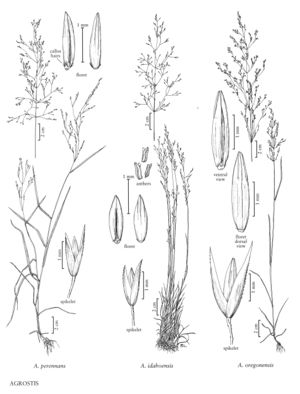Difference between revisions of "Agrostis idahoensis"
FNA>Volume Importer |
imported>Volume Importer |
||
| (8 intermediate revisions by 2 users not shown) | |||
| Line 7: | Line 7: | ||
|synonyms={{Treatment/ID/Synonym | |synonyms={{Treatment/ID/Synonym | ||
|name=Agrostis filiculmis | |name=Agrostis filiculmis | ||
| − | |authority= | + | |authority= |
| − | }}{{Treatment/ID/Synonym | + | |rank=species |
| + | }} {{Treatment/ID/Synonym | ||
|name=Agrostis tenuis | |name=Agrostis tenuis | ||
|authority=Vasey | |authority=Vasey | ||
| + | |rank=species | ||
}} | }} | ||
|hierarchy=Poaceae;Poaceae subfam. Pooideae;Poaceae tribe Poeae;Agrostis;Agrostis idahoensis | |hierarchy=Poaceae;Poaceae subfam. Pooideae;Poaceae tribe Poeae;Agrostis;Agrostis idahoensis | ||
| Line 23: | Line 25: | ||
-->{{Treatment/Body | -->{{Treatment/Body | ||
|distribution=Colo.;N.Mex.;Wash.;B.C.;Utah;Alaska;Idaho;Mont.;Wyo.;Ariz.;Calif.;Nev.;Oreg. | |distribution=Colo.;N.Mex.;Wash.;B.C.;Utah;Alaska;Idaho;Mont.;Wyo.;Ariz.;Calif.;Nev.;Oreg. | ||
| − | |discussion=<p>Agrostis idahoensis grows in western North America, from British Columbia to California and New Mexico, in alpine and subalpine meadows along wet seepage areas and bogs, and in wet openings with Sphagnum in coniferous forests. It was recently discovered in Chile and Argentina; it is not known whether it is native or introduced there (Rugolo de Agrasar and Molina 1997). Agrostis idahoensis is often confused with A. mertensii (p. 644) and dwarf forms of A. scabra (p. 646), both of which tend to grow in better-drained habitats.</p> | + | |discussion=<p><i>Agrostis idahoensis</i> grows in western North America, from British Columbia to California and New Mexico, in alpine and subalpine meadows along wet seepage areas and bogs, and in wet openings with <i>Sphagnum</i> in coniferous forests. It was recently discovered in Chile and Argentina; it is not known whether it is native or introduced there (Rugolo de Agrasar and Molina 1997). <i>Agrostis idahoensis</i> is often confused with <i>A. mertensii</i> (p. 644) and dwarf forms of <i>A. scabra</i> (p. 646), both of which tend to grow in better-drained habitats.</p> |
|tables= | |tables= | ||
|references= | |references= | ||
| Line 32: | Line 34: | ||
-->{{#Taxon: | -->{{#Taxon: | ||
name=Agrostis idahoensis | name=Agrostis idahoensis | ||
| − | |||
|authority=Nash | |authority=Nash | ||
|rank=species | |rank=species | ||
| Line 39: | Line 40: | ||
|basionyms= | |basionyms= | ||
|family=Poaceae | |family=Poaceae | ||
| + | |illustrator=Sandy Long | ||
| + | |illustration copyright=Utah State University | ||
|distribution=Colo.;N.Mex.;Wash.;B.C.;Utah;Alaska;Idaho;Mont.;Wyo.;Ariz.;Calif.;Nev.;Oreg. | |distribution=Colo.;N.Mex.;Wash.;B.C.;Utah;Alaska;Idaho;Mont.;Wyo.;Ariz.;Calif.;Nev.;Oreg. | ||
|reference=None | |reference=None | ||
| Line 44: | Line 47: | ||
|publication year= | |publication year= | ||
|special status= | |special status= | ||
| − | |source xml=https:// | + | |source xml=https://bitbucket.org/aafc-mbb/fna-data-curation/src/200273ad09963decb8fc72550212de541d86569d/coarse_grained_fna_xml/V24/V24_916.xml |
|subfamily=Poaceae subfam. Pooideae | |subfamily=Poaceae subfam. Pooideae | ||
|tribe=Poaceae tribe Poeae | |tribe=Poaceae tribe Poeae | ||
Latest revision as of 17:25, 11 May 2021
Plants perennial; cespitose, not rhizomatous or stoloniferous. Culms 8-40 cm, slender, erect, with 2-5 nodes. Leaves mostly basal; sheaths usually smooth, sometimes scabridulous, not inflated; ligules (0.7)1-3.8 mm, dorsal surfaces scabridulous, apices rounded to truncate, rarely acute, erose to lacerate; blades 1-7 cm long, 0.5-2 mm wide, flat, becoming involute. Panicles 3-13 cm long, 1-6(8) cm wide, lanceolate to ovate, diffuse, exserted from the upper sheaths at maturity, lowest node with 1-6(10) branches; branches scabridulous, fairly stiff, more or less ascending, branching at or above midlength, spikelets not crowded, frequently solitary, lower branches 1-4 cm; pedicels 0.5-6.4 mm. Spikelets lanceolate to narrowly ovate, purplish. Glumes subequal, 1.5-2.5 mm, 1-veined, usually scabrous to scabridulous, upper glumes sometimes smooth, apices acute to acuminate; callus hairs to 0.3 mm, sparse; lemmas 1.2-2.2 mm, usually smooth, sometimes scabridulous, translucent to opaque, 5-veined, veins usually prominent at least distally, sometimes obscure, apices acute to obtuse, entire, unawned; paleas absent, or to 0.2 mm and thin; anthers 3, 0.3-0.6 mm. Caryopses 1-1.3 mm. 2n = 28.
Distribution
Colo., N.Mex., Wash., B.C., Utah, Alaska, Idaho, Mont., Wyo., Ariz., Calif., Nev., Oreg.
Discussion
Agrostis idahoensis grows in western North America, from British Columbia to California and New Mexico, in alpine and subalpine meadows along wet seepage areas and bogs, and in wet openings with Sphagnum in coniferous forests. It was recently discovered in Chile and Argentina; it is not known whether it is native or introduced there (Rugolo de Agrasar and Molina 1997). Agrostis idahoensis is often confused with A. mertensii (p. 644) and dwarf forms of A. scabra (p. 646), both of which tend to grow in better-drained habitats.
Selected References
None.
